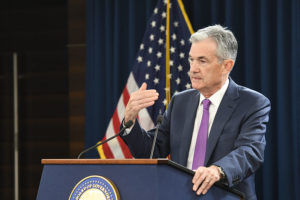
FOMC Chairman Powell answers a reporter’s question at the press conference. September 26, 2018. Photo courtesy of the Federal Reserve.
There’s a saying in finance that you shouldn’t fight the Fed. What that means generally, is that if the Fed is encouraging riskier or less risky behavior with its policies, you should go along.
But what happens when the Fed is giving mixed policy signals? The Fed increased rates as recently as December 20, and was discussing further hikes even later. Now, in June markets see the Federal Open Market Committee signaling two possible rate cuts in 2019. That’s a neck snapping change of course.
Such turnabouts aren’t new for the Fed though. Back in April 1995 I wrote:
In recent testimony to the Senate Banking Committee, Fed Chairman Greenspan told the committee that the economy is slowing. He indicated that rates may have peaked and in fact soon could reverse to the downside.
Greenspan’s report, I believe, was a politically based oddity. Not two weeks earlier in a speech in Honolulu, Greenspan said signs of a slowing economy were scant and inflation pressures remained worrisome. Had conditions changes so much in a matter of less than two weeks? Of course not. Mr. Greenspan was playing politics pure and simple. He wants to be renominated for a new term as Fed chairman.
I’m not suggesting the Powell-Fed is playing politics today, but I am suggesting that you must prepare yourself for rapid changes in Fed policy. You must develop an investment plan resilient enough to withstand Fed shocks. My favored strategy for doing so is building income producing portfolios that seek to avoid risk where possible. If you haven’t already developed a similar investment plan, I suggest you do so today.
Originally posted on Young’s World Money Forecast.
If you’re willing to fight for Main Street America, click here to sign up for my free weekly email.




